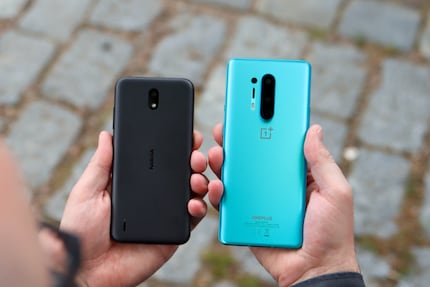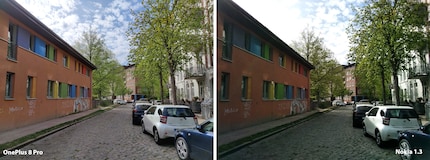
Product test
Nokia 1.3 tested: This is how good a very affordable smartphone is
by Jan Johannsen
Is the OnePlus 8 Pro really ten times better than the Nokia 1.3? The price difference suggests so. I tried it out with everyday things.
Favourable versus expensive: I already knew who would win the duel between the Nokia 1.3 and the OnePlus 8 Pro after my individual tests. Nevertheless, I want to know how big the differences between the smartphones are in practice. To do this, I look at the cameras and the response and charging times, among other things.
Of course, the OnePlus 8 Pro not only has the larger touchscreen at 6.78 inches, but also the technologically better screen with an AMOLED display and a resolution of 3168×1440 pixels as well as a greater colour depth. There's no shaking that. But that doesn't make the 5.71-inch touchscreen of the Nokia 1.3 unusable. The colours of the LC display may not be quite as vibrant and the resolution is significantly lower at 1520×720 pixels. Nevertheless, the screen is bright enough for use in the sunshine and has a sharp and detailed display. At 295 ppi, its pixel density is also only just below the 300 ppi limit, above which a screen no longer becomes sharper to the human eye.

The size of the smartphones and the materials used are differences that immediately catch the eye and can be felt. The Nokia 1.3 has a plastic back, which is non-slip and not ugly, but the glass back of the OnePlus 8 Pro looks nicer. Although there are of course different preferences depending on the colour variant.
The back of the Nokia is removable and you can replace the battery. At 3000 mAh, it has a lower capacity than the permanently installed 4500 mAh battery of the OnePlus 8 Pro. The differences in battery life are less relevant than the charging speed. Thanks to fast charging technology, the OnePlus has to spend significantly less time plugged in and can be charged wirelessly.

While you have to plug headphones into the USB-C port on the OnePlus, the Nokia has a classic 3.5 mm headphone jack. If you connect headphones or speakers via Bluetooth, the range is different for the two smartphones. The OnePlus 8 Pro goes further with Bluetooth 5.1 than the Nokia 1.3 with Bluetooth 4.2. Without obstacles, the difference is around 120 metres to 30 metres. Very important! The Nokia 1.3 does not have an NFC chip and is therefore not suitable for contactless payments.
The Snapdragon 855 in the OnePlus 8 and the 215 mobile platform in the Nokia 1.3 mark the upper and lower end of Qualcomm's current chipset range. The RAM of 12 and 1 gigabyte could hardly be further apart. It is clear in advance which smartphone has more power, but this also applies to the Porsche 911 and the Trabi. Their difference in performance is levelled out on the road by speed limits. Is there a similar effect with smartphones?
The "Work 2.0 Performance" benchmark test from PCMark, which simulates processes, makes the expected performance difference visible in figures. 3491 points for the Nokia compared to 11126 points for the OnePlus. This is a significant difference, but not as big as the price difference.

The difference in the scores achieved in the Antutu benchmark is significantly greater. The Nokia achieved 52104 points and the OnePlus 466938 points. Here, the results are in a similar ratio to the prices. However, the graphics chip of the Nokia 1.3 was too weak to compete. It would only be fair to deduct 128132 points from the OnePlus 8 Pro. But even with 338806 points, the gap is still clear. I would also have liked to try Geekbench, but the app does not run on the Nokia 1.3.

What these figures mean in everyday life, i.e. with a speed limit, can be seen when you look at how long apps take to start.
| App | OnePlus 8 Pro | Nokia 1.3 |
| Open Google Maps | 1 second | 9 seconds |
| Start camera app | 1 second | 2 seconds |
| Call up galaxus.de via Google Assistant | 3 seconds | 13 seconds |
| Open Play Store | 1 second | 4 seconds |
| View settings | <1 second | 1 second |
To stick with the car analogy: The Nokia 1.3 is the Trabant that is fast enough to be allowed on the motorway, but its speed is still far from the speed limit.
With smartphone cameras, the importance of resolution in megapixels has diminished. That's why I'm not writing off the Nokia 1.3 with its 8- and 5-megapixel cameras prematurely. I want to know whether the camera software still stands a chance against the 48- and 16-megapixel camera of the OnePlus 8 Pro. I haven't captured the additional photographic options that the OnePlus offers with its wide-angle and telephoto lens in pictures. For them, I refer you to my test of the 8 Pro.


There is a similar gap between the Nokia 1.3 and the OnePlus 8 Pro in terms of camera and price. The Nokia lags far behind in terms of detail accuracy and colour reproduction. Even the HDR mode on the Nokia does not improve the reproduction of high-contrast areas. On the contrary: the level of detail decreases even further.

Even with just one camera, the Nokia 1.3 offers a portrait mode in which the person being photographed is in focus and the background is blurred. However, the software only creates a rough frame around the face. As a result, the background is also in focus around the edges and parts of the body are blurred. The software of the OnePlus 8 Pro has an easy time presenting a better image here.


If there are still some light sources in the dark, the Nokia still manages to produce a recognisable image. However, the OnePlus outperforms it even without active night mode in terms of detail accuracy and the handling of particularly bright and dark areas. The fewer light sources there are, the more the OnePlus software extends its lead.


For the selfies, the differences in quality are not as great as with the main camera. Even the OnePlus 8 Pro has problems with an overexposed sky, but still has more details and realistic colours. When I activate HDR, the overexposed area gives way to a blue sky with white clouds. However, the image quality of the Nokia 1.3 could then pass for a comic.
[[small:]]
In terms of display, the gap between the Nokia 1.3 and the OnePlus 8 Pro is smaller than I expected. The hardware depends on your patience and the cameras of the two smartphones are worlds apart. The OnePlus also has other features that justify a significantly higher price than the Nokia. But nine to ten times as expensive?
In the single test of the Nokia 1.3, my recommendation is to spend a little more money. Following this logic, I would next make a similar comparison between a mid-range and a top smartphone.
In the end, only one question remains: Which device combination interests you?
When I was but a young student, I'd sit in my friend's living room with all my classmates and play on his SuperNES. Since then I've had the opportunity to test out all the newest technology for you. I've done reviews at Curved, Computer Bild and Netzwelt, and have now arrived at Galaxus.de.